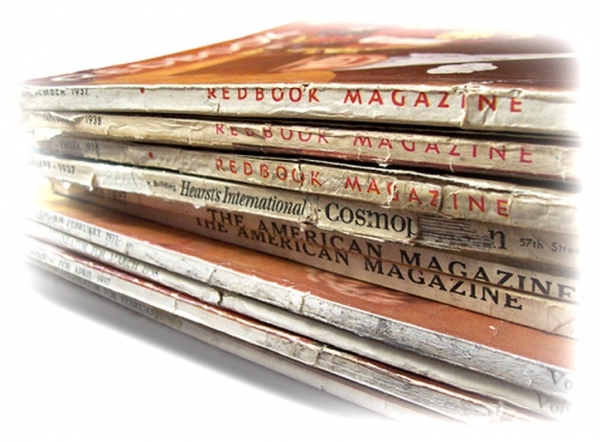
"Forty years ago the Boston publisher, Phillips, with the assistance of that famous coterie of American writers that included Longfellow, Lowell, Emerson, Whittier, Holmes, Motley, Quincy, Parker, Cabot and Underwood launched
The Atlantic Monthly" "It was Holmes who named the magazine, and it was he, probably, more than any other, who assured its success... The prime object of The Atlantic was in the beginning and has continued to be the making of American literature, 'to hold literature above all other human interests.'"
Click here to read the articles from The Atlantic Monthly Here is a tidy little essay that explains the origins of the National Geographic Society and their well-loved magazine. The article begins with an interesting story about what this organization did to help the Pentagon during the Second World War. PM (1940 - 1948) was a left-leaning, New York-based evening paper that enjoyed some notoriety across the fruited plane on account of its founding editor, Ralph Ingersoll (1900 - 1985), who liked to believe that his steady mission was to create "A tabloid for literates":
Contributors included Theodor Geisel (aka Dr. Seuss), I. F. Stone, Ad Reinhardt, J.T. Winterich, Leane Zug‐Smith, Louis Kronenberger and Ben Hecht; the photographs of Margaret Bourke‐White and Arthur Felig (aka Weegee) appeared regularly. Occasional contributors included Erskine Caldwell, Myril Axlerod, McGeorge Bundy, Saul K. Padover, Heywood Broun, James Thurber, Dorothy Parker, Ernest Hemingway, Eugene Lyons, Earl Conrad; Ben Stolberg, Malcolm Cowley.
Preferring to rely more on subscribers than advertisers, PM only lasted eight years. PATHFINDER MAGAZINE was a pretty terrific news organ and to thumb through any of the issues spanning 1910 through 1922 you'll get the sense that it had a heavy hand in influencing TIME, NEWSWEEK and any number of other magazines that came later. Established in Washington, D.C. in 1894, PATHFINDER earned its reputation as a genuine source for domestic and international news.
This article was written by its last publisher, Graham Patterson, and it served as both a history of that weekly as well as an obituary for its founder, George Mitchell - which is entirely fitting because the whole enterprise folded four and half years later. By the time its final issue rolled off the press in 1952 it had become the second largest news magazine in America - with a circulation numbering 1,200,000. With a record like that it seems odd that it went under at all.
Click here to read our collection of articles from PATHFINDER MAGAZINE. Written by one of the underpaid ink-slingers who toiled silently on the corner of Dayton and Rodeo Drive, is the skinny on that unique magazine published in Beverly Hills, California between the years 1929 through 1949, Rob Wagner's Script . It was an exceptional magazine that took courageous stands on a number of moral issues, such as the wartime incarceration of Japanese-Americans. As a product of Los Angeles it not only addressed a good many issues involving Hollywood but also published the writings of Walt Disney, Dalton Trumbo, Ray Bradbury and Charlie Chaplin. From a graphic stand-point it was, perhaps, a bit envious of the New Yorker, but "Script" also laid claim to a number of fine cartoonists; Leo Politi (1908 – 1996) worked for a time as the magazine's Art Director. In the late Forties Salvador Dali contributed cover illustrations. We recommend that you read the attached article and suggest that you surf over to Wikipedia for additional history concerning this magazine. . It was an exceptional magazine that took courageous stands on a number of moral issues, such as the wartime incarceration of Japanese-Americans. As a product of Los Angeles it not only addressed a good many issues involving Hollywood but also published the writings of Walt Disney, Dalton Trumbo, Ray Bradbury and Charlie Chaplin. From a graphic stand-point it was, perhaps, a bit envious of the New Yorker, but "Script" also laid claim to a number of fine cartoonists; Leo Politi (1908 – 1996) worked for a time as the magazine's Art Director. In the late Forties Salvador Dali contributed cover illustrations. We recommend that you read the attached article and suggest that you surf over to Wikipedia for additional history concerning this magazine. Unlike other publications that enter this world with high ideals and lofty ambitions in matters concerning free-speech, the right-to-know, good form and all that sort of stuff - only to slowly devolve into petty, libelous innuendo rags before they cease publication altogether - the British daily The News of The World (1843 - 2011) made its appearance on Fleet Street seeming as if it was already on its way out. As the saying goes, it sold out early and beat the rush.
Although its earliest editions covered the Crimean War, as well as all the other Victorian military adventures, the paper's editorial policy had always been positioned somewhere to the left of Whoopee.
|
MORE ARTICLES >>> PAGE: * 1 * 2 * 3 * 4 * |
|
|